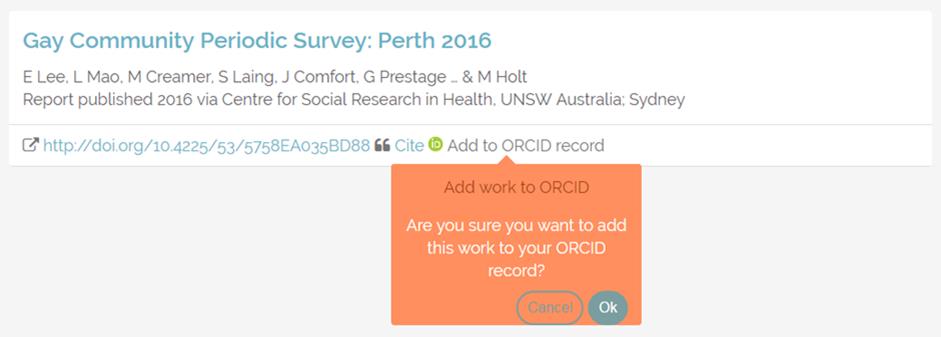- What is grey literature?
- What is a DOI?
- What is the publication file?
- How do I use my DOI as a URL to access and link to the record?
- Why should I get a DOI for my grey literature?
- What is DOI ‘minting’?
- What types of grey literature can have a DOI minted in the UNSW DOI Service?
- Why is my item not appearing in Browse?
- What is a Handle?
- Why can’t I see my DOI in the UNSWorks repository?
- Is there a cost associated with using the UNSW DOI Service?
- Where will I see the DOI once it is minted?
- Why should I ask for the DOI to be added to the publication file?
- Can I update my record after receiving a DOI?
- Pro Tip: ORCID, ROS and the UNSW DOI Service
What is grey literature?
Grey literature is produced by organisations that do not have publishing as their main function. Grey literature can be published by government, industry or universities.
What is a DOI?
DOI stands for Digital Object Identifier.
A DOI is a digital identifier of an object. DOIs are unique and assigned permanently to an object.
Objects may be physical (e.g. a clay sculpture) or digital (e.g. a conference paper in pdf format).
A DOI has three important elements:
- A DOI name, which is a string of numbers and letters starting with ‘10.’. For example, 10.4225/53/5758EA035BD88
- A URL, which can be accessed by adding http://doi.org/ before the DOI name. For example, http://doi.org/10.4225/53/5758EA035BD88
- The URL resolves to a page where metadata (information about the object) is displayed. If the object is digital, it may be available for download from this page.
DOIs are an internationally recognised and supported standard, governed by the International DOI Foundation. For more information about DOIs, see the DOI Guide by the Australian National Data Service.
What is the publication file?
The publication file is the digital file of the grey literature that is in the UNSWorks repository as an attachment.
How do I use my DOI as a URL to access and link to the record?
Access and link to your record by adding http://doi.org/ before the DOI name. For example:
10.4225/53/5758EA035BD88 becomes http://doi.org/10.4225/53/5758EA035BD88
Anyone, anywhere can click on this URL and will be taken to the record of your work in UNSWorks repository.
Why should I get a DOI for my grey literature?
A DOI makes it easier for other researchers to find your work, use it, share it and cite it.
You can add your DOI to the citation to provide a persistent link to your work.
Grey literature especially benefits from having a DOI as it is often not as easy to find as work published by major publishers.
Altmetric tools can record when a DOI appears in online sources and services (e.g. news sources, social media, Wikipedia). You can then use altmetrics to better understand how your work is being discussed and shared by other scholars and the public. For more information see Research impact guide: Altmetrics or contact your Outreach Librarian.
What is DOI ‘minting’?
The process of creating and assigning a DOI to an object is known as minting. You refer to a new DOI being ‘minted’ in the same way that you refer to a new coin being ‘minted’.
What types of grey literature can have a DOI minted in the UNSW DOI Service?
You can request a DOI for the following types of grey literature using the UNSW DOI Service:
- Conference item
- Conference paper
- Conference poster
- Creative works (non-textual)
- Creative written works
- Music composition
- Media item
- Other
- Report
- Working paper
- Submission to Government
The UNSW DOI Service cannot mint DOIs for the following resource types:
- Book chapter
- Book
- Conference presentation
- Curatorial output
- Designs / Architecture
- Films, TV, Media
- Journal article (any version of an article)
- Patent
- Software
If you require a DOI for a resource type that is not included in the UNSW DOI Service, please contact your Outreach Librarian.
Why is my item not appearing in Browse?
Browse will only find research outputs of certain grey literature types. Allowed resource types are listed under What types of grey literature can I submit a DOI request for?
If your publication is an allowed resource type and cannot be found in Browse, please contact a DOI Service Administrator (doiservice@unsw.edu.au).
What is a Handle?
A Handle is a type of persistent identifier.
In UNSW Library repositories, each record has a Handle which is displayed as shown in the example:

When using the UNSW DOI Service, entering the Handle into the search box is the easiest way to find a particular record.
Why can’t I see my DOI in the UNSWorks repository?
After minting a DOI it takes 2 to 3 working days for the DOI to appear in UNSWorks repository.
When it does appear it will appear here:

If it does not appear after this time, contact a DOI Service Administrator (doiservice@unsw.edu.au).
Is there a cost associated with using the UNSW DOI Service?
No, this is a free service.
Where will I see the DOI once it is minted?
You will receive a confirmation email containing the DOI once it is minted.
The DOI will also appear in the 'Details' tab of the UNSWorks repository record 2 to 3 working days after being minted.
It will appear here:

Why should I ask for the DOI to be added to the publication file?
If the DOI is added to the publication file, a reader who downloads the file can easily find and use the DOI to cite and share your work. Including the DOI in the publication file is common practice for journal articles and other research outputs published commercially.
If you select this option, the DOI will be added alongside other publication information.
For example:

Can I update my record after receiving a DOI?
Before submitting a DOI request, you are required to agree to a statement that the resource is not likely to change significantly.
A major change is defined as a change to the attached publication file or any information that would be used in a citation (authors, title, publisher, publication year).
If you make major change to your record, you will need to request a new DOI.
Pro Tip: ORCID, ROS and the UNSW DOI Service
An ORCID (Open Researcher and Contributor iD) is a unique, persistent identifier for researchers that helps distinguish your research activities and outputs from those of other researchers with similar names to ensure you get credit for your work.
You can find out how to get an ORCID iD and add your ORCID iD to ROS on the UNSW Library website. If you need help, please contact your Outreach Librarian.
It is recommended that you link your ORCID iD to ROS before using the UNSW DOI Service. Records deposited in ROS that are given a DOI through the UNSW DOI Service can then be easily added to your ORCID profile by following the steps below.
- Go to DataCite Profiles, sign in with your ORCID credentials and select Settings.
- Under ORCID Claims, add works manually or enable ORCID Auto-Update.


Manual: Search for your works and add them to your ORCID profile.

Auto-Update: Select enable.
